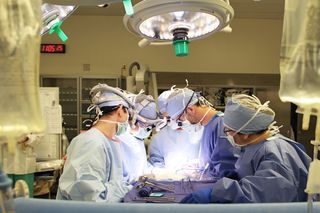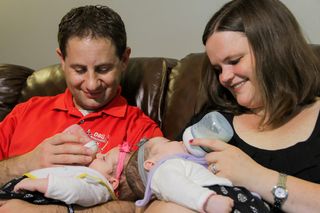
Facing Organ Donor Shortage, Patients Forced to Get Creative

Dr. Todd Pesavento is medical director of kidney and pancreas transplantation and interim executive director of the Comprehensive Transplant Center at The Ohio State University Wexner Medical Center. Pesavento contributed this article to Live Science's Expert Voices: Op-Ed & Insights.
Every 10 minutes, another name goes on the list of Americans waiting for an organ transplant. Currently, the list of patients awaiting a donation is more than 122,000 names long. Most of those patients will have to wait months or even years before finding a donor organ, and unfortunately, some never will. By the end of the day, 22 more people will die while awaiting a donor organ.
The problem is, there simply aren't enough donors to meet demand. Most states have tried to bring attention to the issue by giving drivers the opportunity to become donors upon getting or renewing their driver's licenses. In May, the U.S. Senate introduced the Organ Donation Awareness and Promotion Act of 2015, and though it's yet to be voted on, it would fund efforts to further promote organ donation and raise awareness of the ongoing shortage.
Despite those efforts, according to the U.S. Department of Health and Human Services (HHS), the number of donors available nationwide has remained stagnant over the last decade. In 2005, there were 14,497; last year, there were 14,415. And the number of living donors from whom organs were recovered actually dropped over the same time period, by more than 16 percent.
Not content to just sit and wait, patients are increasingly taking matters into their own hands and actively looking for potential living donors.
Finding donors, any way we can
At the Comprehensive Transplant Center in The Ohio State University's Wexner Medical Center, we're seeing patients use everything from signs to social media to elicit donors.
Sign up for the Live Science daily newsletter now
Get the world’s most fascinating discoveries delivered straight to your inbox.
After one of our patients was put on a waiting list for a kidney , for example, his wife took to Facebook to share her husband's story and ask for donors. In less than a week, he had one. A former classmate of his wife's came forward to donate a kidney, and this past July, the couple celebrated the fifth anniversary of the transplant. [The 9 Most Interesting Transplants ]
Another patient in need of a kidney at our center not only has a Facebook page, but also painted a plea for help on her SUV, providing details of her situation, her phone number and even her blood type. Though she's yet to find a suitable donor, she's generated dozens of phone calls and, on a broader scale, raised awareness among passersby about the possibility of becoming a living donor.
I find in my practice that many people want to help, but they simply didn't know they could. Whenever someone comes forward to donate to one of my patients, I ask how they learned about becoming a living donor. Invariably, they say they saw a story on the news, read something in a newspaper or, increasingly, happened to notice something on social media.
Hopefully, if you're one of those who didn't know you could become a living donor, perhaps you'll sign up after reading this.

The good news is that the donor pool has broadened considerably over the last two decades. In the past, because of the risk of the recipient's body rejecting the transplanted organ, it was thought that only immediate family members could be donors. Today, advancements in surgical techniques such as vascular anastomosis and the use of robotics requiring less invasive incisions, combined with improvements in anti-rejection medications, there are fewer limits to who can donate — especially for kidneys.
According to HHS, in the United States, there is a far greater need for kidney transplants than for any other organ. More than 100,000 people are waiting for donor kidneys, four times as many as all other organs combined.
That's where living donors could make such a big impact. According to the United Network for Organ Sharing, kidneys are the most common organ transplanted from living donors; the United States just doesn't have enough of them.

Ohio State is one of the larger transplant centers in the country. Currently, we have about 800 people on the wait list for a kidney, and next year we anticipate evaluating 800 more patients for transplant. Every year, we perform transplants for about 240 people, with about half of those patients receiving transplants from a living donor.
You can see why we're not making much headway in shortening our waitlist, but perhaps that will change. The vast majority of kidney donors recover in weeks and can return to normal activities in several months. Generally, the costs associated with donating a kidney are covered by nearly all insurance companies, so the donors do not incur any medical expenses. Many states have laws to allow for time off from work and tax credits for any costs that insurance does not cover.
As more patients take the initiative to share their personal stories, more people are learning about the desperate need for donors. And whether it's because of the vast reach and immediate impact of a post on social media, or simply because they saw a sign painted on a car, more people are learning about opportunities to help.
Hopefully, by reading this, you learned something, too.
Follow all of the Expert Voices issues and debates — and become part of the discussion — on Facebook, Twitter andGoogle+. The views expressed are those of the author and do not necessarily reflect the views of the publisher. This version of the article was originally published on Live Science.
